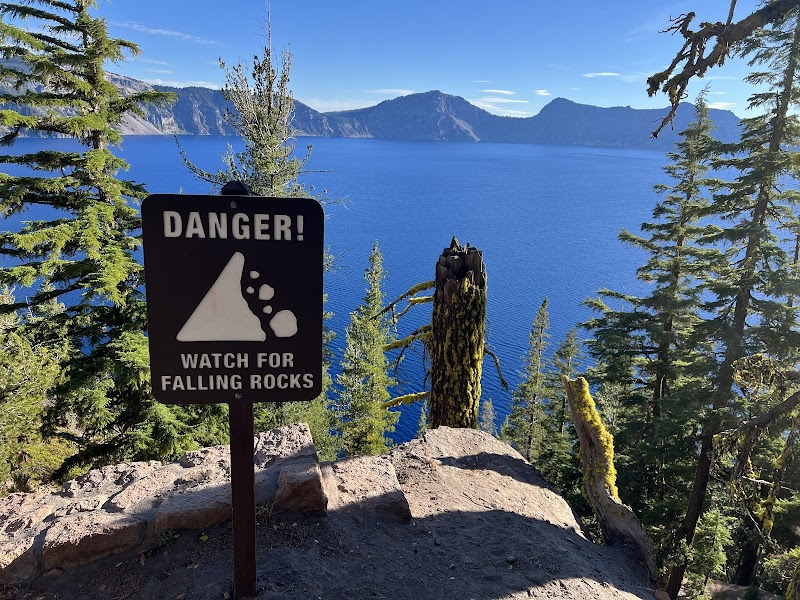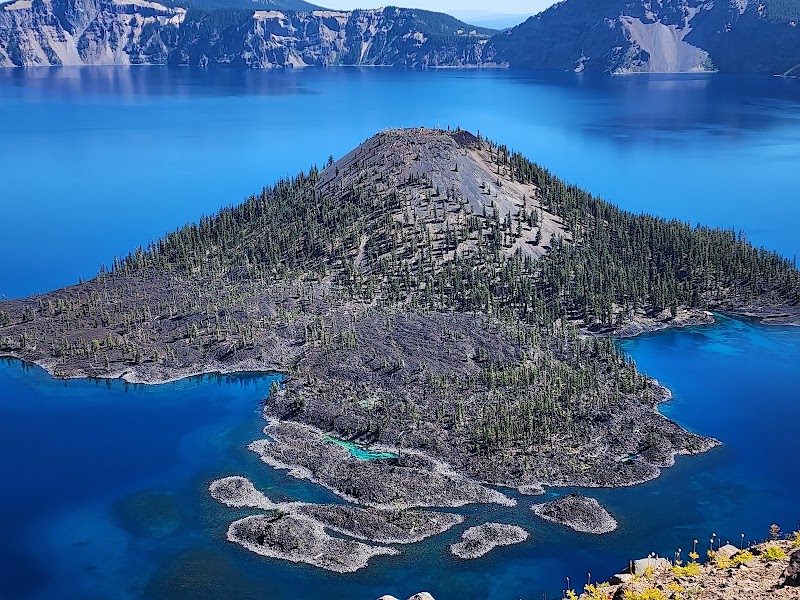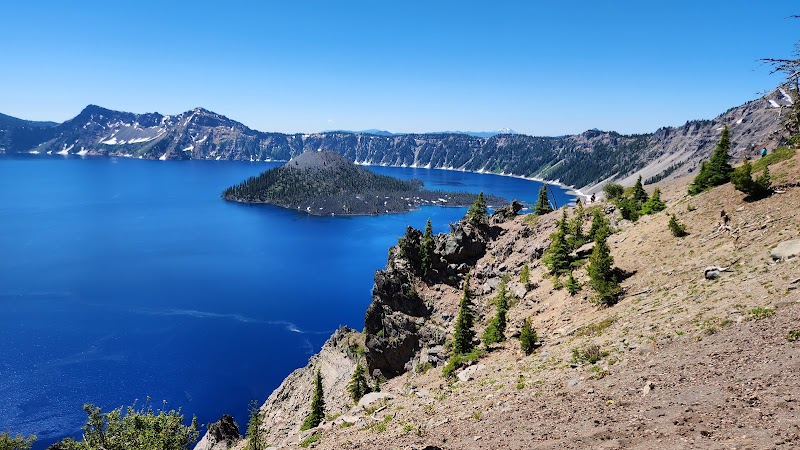Experience the peace and serenity of Crater Lake National Park, home to the deepest lake in the United States. Here, you can marvel at the striking blue waters of Crater Lake, admire the grandeur of the surrounding cliffs, and absorb the tranquility of the serene parkland. The magnificent contrast between the ancient volcanic remnants and the lush green forests generates a panoramic view that will captivate your heart and mind.
Properly planning your adventure is crucial, and the in-depth tourist map of Crater Lake National Park acts as a vital guide, allowing you to navigate the park's attractions at your own pace. This useful tool gives a holistic view of the park and encourages you to explore lesser-known paths and hidden gems. With so much to see and do, the map will be your steadfast companion, ensuring you fully enjoy every moment.
Booking.comBringing to Light the Wonders of Crater Lake National Park
Esteemed as a gemstone in the Pacific Northwest, Crater Lake National Park offers a host of unforgettable views and adventures. With its panoramic landscapes to its tranquil forests, this natural paradise is brimming with attractions that will mesmerize and inspire. Here's a sneak peek into some of the park's most sought-after attractions:
- Rim Drive
- Wizard Island
- Pinnacles Overlook
- Godfrey Glen Trail
- Phantom Ship
- Crater Lake Lodge
Feel the Magic of Rim Drive
Surrounding the sapphire waters of Crater Lake, the Rim Drive offers a 33-mile journey with unparalleled beauty. This scenic route lets you immerse yourself in the park's breathtaking landscapes, from its towering cliffs to its lush meadows. Not only does the Rim Drive offer stunning views of the lake and the park, but it also opens up pathways to numerous trails and overlooks that lead to less explored corners of the park.
Unlock the Mystery of Wizard Island
Peaking above the gleaming blue surface of Crater Lake, Wizard Island is a fascinating volcanic cinder cone that adds an air of mystique to the tranquil lake. The island offers a unique hiking experience with a summit that rewards you with breathtaking views of the surrounding lake and caldera. This island is also home to the Witches Cauldron, a lesser-known but equally interesting crater that stands as a testament to the area's dynamic volcanic history.
Admire the Pinnacles Overlook
In the southeastern corner of the park, you'll find the Pinnacles Overlook, a geological wonder that showcases the park's volcanic history. These towering spires of hardened ash, sculpted by wind and water over thousands of years, stand as silent guardians overlooking the Sand Creek Canyon. The contrast of these delicate structures against the rugged landscape of the park is a sight to behold.
Take a Leisurely Stroll Along Godfrey Glen Trail
For a leisurely hike amidst the park's verdant landscapes, try the Godfrey Glen Trail. This 1-mile loop trail meanders through a delightful mix of old-growth forest and open meadows, offering splendid views of the park's diverse flora and fauna. Along the way, you might also spot some of the park's wildlife, from squirrels and chipmunks to a variety of bird species.
Explore the Phantom Ship
Resembling a ghostly galleon adrift on the lake, the Phantom Ship is another testament to Crater Lake's volcanic history. This rock formation, a remnant of an ancient volcano, can be viewed from the Sun Notch viewpoint. Its eerie silhouette set against the backdrop of Crater Lake's tranquil waters creates a captivating sight.
Relax at Crater Lake Lodge
Finally, no visit to Crater Lake National Park would be complete without a stay at the historic Crater Lake Lodge. This iconic lodge offers a blend of rustic charm and modern comfort, with panoramic views of the lake right from your window. It's the perfect spot to relax at the end of a day filled with adventure.
To make the most of your visit, consider using a tourist map of United States to plan your itinerary. It will provide you with a comprehensive overview of Crater Lake National Park's attractions, ensuring that you don't miss out on any of the park's hidden gems.

Practical Information for Crater Lake National Park
Transportation and Mobility
Navigating around Crater Lake National Park requires careful planning. While driving your own vehicle is the most common way to explore the park, note that some road closures may occur due to bad weather, especially during winter months. Alternatively, you can use the park's free summer shuttle service, which travels around Rim Drive and stops at popular viewpoints.
Schedules and Prices
Crater Lake National Park is open 24 hours a day, all year round. However, visitor center hours and services vary with the seasons. Typically, the Rim Village Visitor Center is open daily from 9:30 a.m. to 5 p.m., while the Steel Visitor Center operates from 10 a.m. to 4 p.m. Do remember to check the official site for the most up-to-date schedules.
The entrance fee for a private vehicle is $30, valid for seven days. Individuals entering by foot or bicycle are charged $15. Annual passes are available at $55 and grant unlimited entry for one year from the month of purchase.
Safety Tips
Your safety is crucial while exploring Crater Lake National Park. Always stay on marked trails and keep a safe distance from cliff edges. In winter, be aware of avalanche risks in the park's backcountry. As wildlife is abundant, remember not to feed animals and maintain a safe distance. Always carry a map, plenty of water, and wear suitable clothing for the weather conditions.
Practical Recommendations
The best times to visit Crater Lake National Park are July through September, when all facilities, roads, and services are typically available. If you're looking to avoid crowds, consider visiting on weekdays or arrive early in the day. Lastly, always check the park's website for current conditions and potential closures before you embark on your journey.

Frequently Asked Questions About Crater Lake National Park
1. Are there any special rules for wildlife viewing in Crater Lake National Park?
The park is a sanctuary for a variety of wildlife, and maintaining their space is crucial. It's advised to keep a minimum distance of 100 yards from bears and wolves, and 25 yards from all other wildlife. Feeding wildlife is strictly prohibited as it can harm their health and alter natural behaviors.
2. What unique winter activities can be enjoyed in Crater Lake National Park?
Winter transforms Crater Lake into a snow-covered paradise and offers unique activities. Cross-country skiing and snowshoeing are popular ways to explore the park's winter beauty. Ranger-guided snowshoe walks are available on weekends and holidays from late December through the end of March, providing a unique way to learn about the park's winter ecology.
3. What special precautions are needed for hiking in the park due to its high altitude?
At high altitudes, it's crucial to stay hydrated and protect yourself from the sun. Always carry plenty of water, use sunscreen, wear a hat to shield yourself from the sun, and take regular breaks to rest. If you start feeling dizzy or develop a headache, it could be a sign of altitude sickness and you should descend to a lower elevation immediately.
4. Can I fish in Crater Lake, and are there any specific rules or restrictions?
Yes, Crater Lake offers a unique fishing experience with no license required. However, to maintain the park's natural ecosystem, only artificial lures are permitted and all fishing is catch-and-release.
5. Are there any lesser-known attractions or experiences that are unique to Crater Lake National Park?
Beyond the well-known attractions, Crater Lake also offers star-gazing programs, full moon hikes, and seasonal ranger talks that provide a unique insight into the park's natural and cultural history. Check with the visitor center for current programs during your visit.
6. What is the best time to visit Crater Lake for photography?
Crater Lake is photogenic throughout the year, but the golden hours around sunrise and sunset offer stunning views. The lake's intense blue color contrasts beautifully with the glow of the rising or setting sun. Winter, with its snowy landscapes, also provides unique photographic opportunities.

